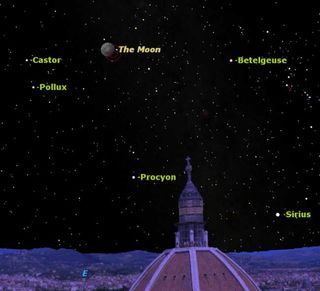Partial Lunar Eclipse and Blue Moon New Year's Eve

Eclipses of the moon occur twice a year, on average. Eacheclipse is visible only on the half of the Earth turned towards the moon at thetime the Earth's shadow falls on the moon.
There will be a partial eclipse of the moon on New Year'sEve, Dec. 31. Because of its timing, it will not be visible in North and SouthAmerica, but will be visible over most of Europe, Africa, and Asia.
The event will also mark the second full moon of the monthin North America, thereby garnering the title of "bluemoon." Unless unusual atmospheric circumstances come into play ? suchas widespread dust from a volcano ? the moon will not be blue, however.
Since it is a partial eclipse, the moon will just brushpast the darkest part of the Earth's shadow, never becoming totally immersed.It will, however, be deep enough into the shadow that shading and reddish colorshould be visible.
Even though the eclipse isn't visible for most of us inNorth America, it's still possible to enjoy this event through astronomysimulation software like StarryNight. An armchair skywatcher can use this software to view the eclipsefrom any point on Earth.
Here's how the eclipse will play out (these times will bethe same for most of western Europe and central Africa):
As the sun sets in the southwest, the full moon rises inthe northeast. At 6:17 p.m. local time Friday the moon begins to enter theEarth's shadow, though it is undetectable at first. At? 7:52, the moon entersthe darkest part of the Earth's shadow, called the umbra. Maximum eclipse is at8:23, and the moon leaves the umbra at 8:53. The last traces of the shadow aregone by 10:28.
Get the Space.com Newsletter
Breaking space news, the latest updates on rocket launches, skywatching events and more!
Observers in other parts of the Old World will have to makeadjustments for their local time zones. Australians may catch a glimpse of theeclipse just before moonset at dawn on Jan. 1. Again, the eclipse is notvisible from the Americas.
- Vote:The Best Moon Images
- More Night Sky Features from StarryNight Education
- Top 10 AmazingMoon Facts
Thisarticle was provided to SPACE.com by Starry Night Education, theleader in space science curriculum solutions.
Join our Space Forums to keep talking space on the latest missions, night sky and more! And if you have a news tip, correction or comment, let us know at: community@space.com.

Geoff Gaherty was Space.com's Night Sky columnist and in partnership with Starry Night software and a dedicated amateur astronomer who sought to share the wonders of the night sky with the world. Based in Canada, Geoff studied mathematics and physics at McGill University and earned a Ph.D. in anthropology from the University of Toronto, all while pursuing a passion for the night sky and serving as an astronomy communicator. He credited a partial solar eclipse observed in 1946 (at age 5) and his 1957 sighting of the Comet Arend-Roland as a teenager for sparking his interest in amateur astronomy. In 2008, Geoff won the Chant Medal from the Royal Astronomical Society of Canada, an award given to a Canadian amateur astronomer in recognition of their lifetime achievements. Sadly, Geoff passed away July 7, 2016 due to complications from a kidney transplant, but his legacy continues at Starry Night.
